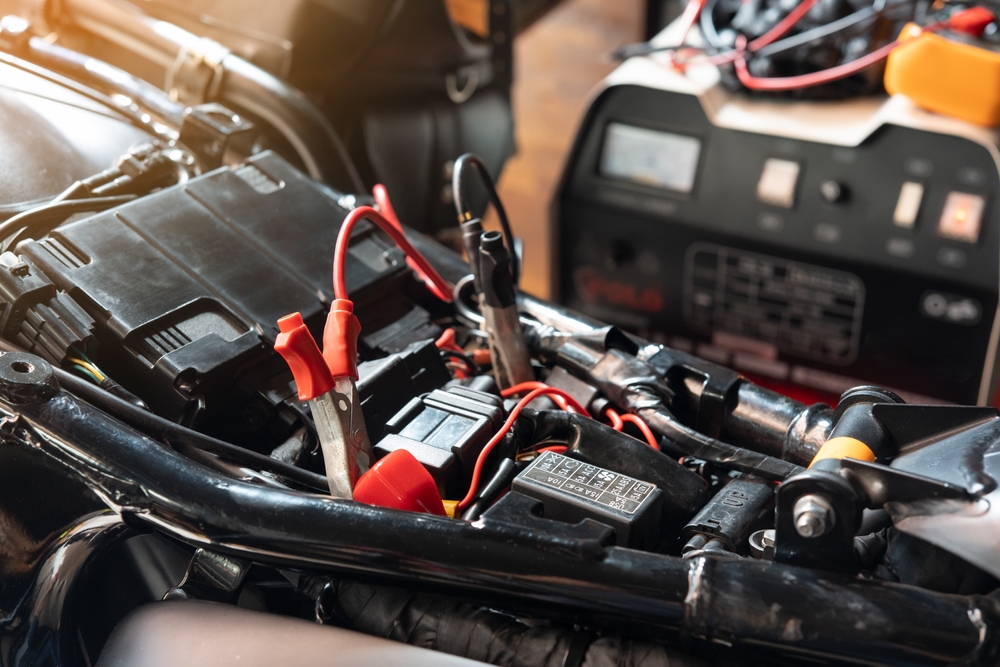
Which Battery Is Right for Your Motorcycle, ATV, or RV?
June 21, 2025 3:59 pm Leave your thoughtsChoosing the right battery for your motorcycle, ATV, or RV is more than just picking the first one that fits. It’s a decision that impacts the longevity, reliability, and performance of your vehicle. Whether you’re hitting the trail, cruising the highway, or parked at your favorite campground, the battery serves as the silent powerhouse behind every ignition, light, and accessory. But with a wide range of powersport battery types available, understanding your options and how to choose a motorcycle battery (or one for your ATV or RV) is critical. Let’s dive into the essentials to make sure you choose the right battery to match your machine and your lifestyle.
Understanding Powersport Battery Types
Powersport battery types fall into several categories, each with unique benefits and tradeoffs. The most common are conventional lead-acid, AGM (Absorbed Glass Mat), gel, and lithium batteries.
Conventional lead-acid batteries are the oldest and most widely used. They’re relatively inexpensive and offer reliable power, but they require regular maintenance. You’ll need to top off the electrolyte levels with distilled water periodically and ensure the terminals stay clean and corrosion-free. These batteries are prone to spillage, so they must remain upright, which can limit mounting flexibility.
AGM batteries, by contrast, are sealed and maintenance-free. They use a special fiberglass mat to absorb the electrolyte, preventing spills and making them vibration-resistant—a great feature for off-road adventures. AGM batteries have become the standard for many modern motorcycles and ATVs due to their longer lifespan and lower self-discharge rate.
Gel batteries take it a step further by suspending the electrolyte in a thick gel, making them even more resistant to vibration and leaks. However, they are more sensitive to overcharging and typically cost more. They’re best suited for high-end applications where deep-cycle capability is important, such as electric scooters or RV accessory systems.
Lithium batteries represent the cutting edge of powersport battery types. They’re incredibly lightweight, charge faster, and last longer than their lead-acid counterparts. Because they have no liquid electrolyte, there’s zero risk of spillage, and they can be mounted in virtually any position. They do require a special charger and are typically more expensive up front, but the long-term value can outweigh the initial cost—especially for performance bikes or demanding RV electrical systems.
How to Choose a Motorcycle Battery (or ATV/RV Battery)
Knowing how to choose a motorcycle battery—or one for an ATV or RV—involves evaluating more than just physical dimensions and voltage. Several factors come into play, including cold cranking amps (CCA), amp-hour (Ah) ratings, size, maintenance requirements, and the demands of your vehicle’s electrical system.
Cold Cranking Amps (CCA) is one of the most critical considerations, particularly if you ride in colder climates. CCA measures the battery’s ability to start an engine in cold temperatures. A battery with higher CCA will provide better reliability in winter or high-altitude environments. For motorcycles and ATVs used year-round, especially in colder regions, this can mean the difference between a smooth start and being stranded.
Amp-Hour (Ah) ratings indicate how much capacity a battery has to deliver power over time. For most motorcycles and ATVs, a battery with a moderate Ah rating is sufficient. However, RVs often need higher-capacity batteries to support interior lighting, refrigerators, water pumps, and other onboard amenities, even when the engine is off.
Next comes the battery size and terminal configuration. It’s crucial to choose a battery that physically fits your battery compartment and matches your vehicle’s terminal orientation. Many batteries come with standard part numbers, like YTX12-BS or YTZ14S, which correspond to specific dimensions and terminal layouts.
You’ll also want to factor in maintenance needs. If you prefer to install it and forget it, a sealed AGM or lithium battery may be best. On the other hand, if you don’t mind occasional check-ups and want to save money, a conventional battery could suffice.
Motorcycle-Specific Considerations
When selecting a battery for your motorcycle, the type of riding you do matters. For daily commuters, reliability and low maintenance are paramount. In this case, an AGM battery strikes a balance between performance and cost-efficiency. It handles stop-and-go traffic well and won’t demand much upkeep.
Sportbike riders and racers might opt for lithium batteries due to their lighter weight and faster recharge rates. The reduced mass can enhance performance and agility—factors that matter on the track or when carving through twisty roads.
Cruiser or touring bike owners often value longevity and the ability to power accessories like heated grips or GPS units. Here, a high-capacity AGM or gel battery might be the better choice. These riders are also likely to benefit from batteries with a lower self-discharge rate, especially if the bike is stored for extended periods.
Storage is another major concern. If your motorcycle spends months in storage during winter, you’ll want a battery that can hold a charge without degrading. Lithium batteries excel in this area, but even an AGM battery can perform well when paired with a smart trickle charger.
ATV and UTV Battery Needs
ATVs and UTVs often see more abuse than motorcycles. From muddy trails and water crossings to bone-jarring terrain, the battery must withstand constant vibration, temperature swings, and unpredictable storage conditions. That’s why many ATV owners gravitate toward AGM batteries.
AGM batteries offer sealed protection against moisture, dirt, and movement. Their rugged build allows them to operate in extreme environments, making them ideal for off-roading, hunting, and farming. Plus, because they don’t require upright installation, they can be positioned more flexibly in tight engine compartments.
For recreational riders who demand performance and want to reduce weight, a lithium battery may still be a good investment—particularly for racing or dune riding. Just be sure to use a compatible charging system to avoid damage, as lithium batteries can be more sensitive to improper voltage.
If your ATV has winches, lights, or stereo systems installed, you’ll want a battery with higher Ah capacity to ensure it doesn’t run out of juice mid-trip. Some UTVs, especially larger side-by-sides, may even support dual battery setups to separate engine start power from accessory loads. In such setups, a combination of lithium and deep-cycle AGM batteries might offer the best of both worlds.
RV Battery Requirements and Smart Upgrades
RVs bring a whole new layer of complexity when it comes to battery selection. These mobile homes require not just a starter battery for the engine, but also deep-cycle batteries to power everything from the lights to the microwave.
The first step in selecting the right battery for your RV is to understand the difference between starter batteries and deep-cycle batteries. Starter batteries provide a short burst of high energy to start the engine. Deep-cycle batteries, on the other hand, are designed to discharge slowly over time and recharge repeatedly. Using the wrong type in the wrong application can lead to premature battery failure.
For deep-cycle applications, AGM and lithium batteries are often preferred. AGM deep-cycle batteries offer good durability, low maintenance, and decent lifespan, making them a solid mid-tier option. Lithium batteries, while pricier, deliver superior performance in every category: longer cycle life, faster charging, lighter weight, and higher energy density.
Solar integration is another consideration. Many RV owners are now installing solar panels to maintain battery charge while boondocking (camping without hookups). Lithium batteries are particularly well-suited to solar setups because they handle frequent partial charging and discharging better than lead-acid types.
Capacity planning is crucial. Calculate the total energy consumption of your RV appliances to determine how many amp-hours you’ll need. Don’t forget to consider inverter efficiency and reserve power for cloudy days. A robust battery monitoring system can help you manage consumption and charge levels more effectively, preventing over-discharge and maximizing lifespan.
Finally, make sure your RV’s charging system—whether it’s a generator, solar controller, or onboard charger—is compatible with your chosen battery type. Lithium batteries often require different charging voltages and protection circuits to perform safely and effectively.
Final Thoughts
Understanding powersport battery types and how to choose a motorcycle battery—or one for your ATV or RV—ensures that your ride performs reliably and safely, no matter where the road or trail takes you. There’s no one-size-fits-all answer. Your ideal battery will depend on your vehicle’s needs, your riding habits, and your maintenance preferences.
Whether you’re a weekend warrior, a long-distance adventurer, or a rugged off-roader, matching the right battery to your machine will improve performance, reduce headaches, and possibly even save you money in the long run. Consider your power demands, storage habits, and terrain. Think about convenience, longevity, and safety.
In the end, investing time into selecting the right battery is a small price to pay for peace of mind and a reliable ride every time you turn the key.
Need a Battery Store in Houston, TX?
At Texford Battery Co, we pride ourselves on being much more than just another battery specialist. We credit our seven decades of business growth and success to the unmatched service and expertise our team provides. Texford Battery Co is not simply a supplier – we helped pave the way for many innovations in the battery distribution industry that continue to keep prices competitive for our customers. Among them, we were a leader in the creation of the Battery Marketing Group in the 1970s. As a founding member of this national network of battery distributors and manufacturers, we are able to offer up to 10,000 of the industry’s top products to our customers at the lowest cost. Call us today!Categorised in: Batteries
This post was written by admin
